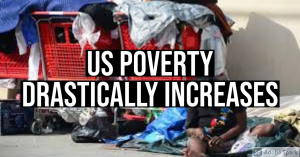There is a mythology in American thinking that prosperty can continue on forever. This is a lie, because prosperity, like good and bad times, ebbs and flows. It is natural to see success, as well as decline.
According to a recent study reported on by Bloomberg and redistributed by MSN Money, poverty in the US is on its fastest rise in fifty years.
The end of 2020 brought the sharpest rise in the U.S. poverty rate since the 1960s, according to a study released Monday.
Economists Bruce Meyer, from the University of Chicago, and James Sullivan of the University of Notre Dame found that the poverty rate increased by 2.4 percentage points during the latter half of 2020 as the U.S. continued to suffer the economic impacts from Covid-19.
That percentage-point rise is nearly double the largest annual increase in poverty since the 1960s. This means an additional 8 million people nationwide are now considered poor. Moreover, the poverty rate for Black Americans is estimated to have jumped by 5.4 percentage points, or by 2.4 million individuals.
The scholars’ findings put the rate at 11.8% in December. While poverty is down from readings of more than 15% a decade earlier, the new estimates suggest that the annual Census Bureau tally due in September will be higher than the last official, pre-pandemic level of 10.5% in 2019.
Black Americans were more than twice as likely to be poor as their White counterparts in December — an improvement from the summer months when they were nearly three times more apt to live in poverty — but an increase from before the pandemic, when the differential was under 2.
Despite improvements in the overall poverty rate since the middle of the 20th century, Black Americans had been about three times as likely to be poor as White Americans for most of the past 60 years. The gap started to narrow after the financial crisis, during the longest economic expansion in history. (source)
The US poverty rate should have naturally been allowed to go higher. It was only hidden because of debt, something which the effects of COVID have forcibly exposed.
It would have been better if there was an increase earlier. This would not mean ‘more poverty for Americans’, but an accurate reflection of debt and earnings, and because of this, would allow for a more managed debt that would benefit all. But this is not what happened, instead resulting in the artificial inflation of value at the expense of the common man trying to save his money. The price had to be paid, but instead of doing it now, it came for the future, which has come.
This is why the government is printing money. It is not just that the people are in debt- they reflect the government, which is even more indebted, and they are trying to ‘keep the economy going’, but it is coming at the cost of the means of exchange itself (the currency).
As I have noted before, poverty is going to be a long-term trend that will affect the supermajority of citizens, especially as the gap between the wealthy and the poor continues to increase rapidly.



